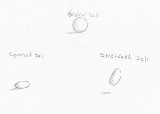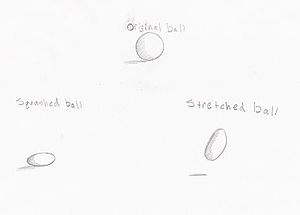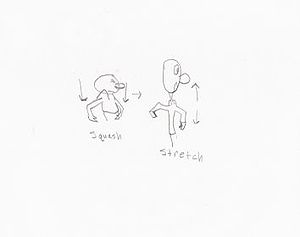
Squash and stretch
Encyclopedia


Animation
Animation is the rapid display of a sequence of images of 2-D or 3-D artwork or model positions in order to create an illusion of movement. The effect is an optical illusion of motion due to the phenomenon of persistence of vision, and can be created and demonstrated in several ways...
technique applied to characters or objects in motion. The technique makes their actions more fluid, and it is generally exaggerated for a cartoonish effect. When utilized with more subtlety, it works just as well for realistic movements. Squash and stretch was used to great effect in early 1920s American cartoons such as Felix the Cat
Felix the Cat
Felix the Cat is a cartoon character created in the silent film era. His black body, white eyes, and giant grin, coupled with the surrealism of the situations in which his cartoons place him, combine to make Felix one of the most recognized cartoon characters in film history...
and Betty Boop
Betty Boop
Betty Boop is an animated cartoon character created by Max Fleischer, with help from animators including Grim Natwick. She originally appeared in the Talkartoon and Betty Boop film series, which were produced by Fleischer Studios and released by Paramount Pictures. She has also been featured in...
. It can also be used in comics
Comics
Comics denotes a hybrid medium having verbal side of its vocabulary tightly tied to its visual side in order to convey narrative or information only, the latter in case of non-fiction comics, seeking synergy by using both visual and verbal side in...
or still cartoon art.
When done in accordance with the principles of animation, squash and stretch keeps the volume of the character constant. This is often explained by analogy to a half-filled sack of flour. In one episode of Tiny Toon Adventures
Tiny Toon Adventures
Steven Spielberg Presents Tiny Toon Adventures, usually referred to as Tiny Toon Adventures or simply Tiny Toons, is an American animated television series created by Tom Ruegger and produced by Amblin Entertainment and Warner Bros. Animation. It began production as a result of Warner Bros....
, Babs Bunny mentions that the technique makes cartoons inherently funnier.
Squash and stretch is the principle of how an object squashes (figure 1.1, left) or how it stretches figure(1.1, right). An example is a classic cartoon "take" (figure 1.2), where it helps make an animation more "life-like" and "solid". When squash and stretch is applied, it creates the illusion that a drawing has dimension and volume. Squash and stretch does not always have to be cartoonlike - when we crouch down in anticipation for a large leap, we squash. When we spring into the air, we stretch. A half-filled flour sack is an example of a more cartoonlike squash and stretch - when dropped the sack squashes a lot; when picked up it stretches a lot - but throughout the entire action, the volume never changes.
Microsoft Research has developed The Cartoon Animation Filter for use with a diverse array of media, including motion capture, video, and digital 2D and 3D animation. "The filter adds a smoothed, inverted, and (sometimes) time shifted version of the second derivative (the acceleration) of the signal back into the original signal. Almost all parameters of the filter are automated. The user only needs to set the desired strength of the filter." The filter automatically creates anticipation, follow-through, exaggeration, and squash-and-stretch effects.

